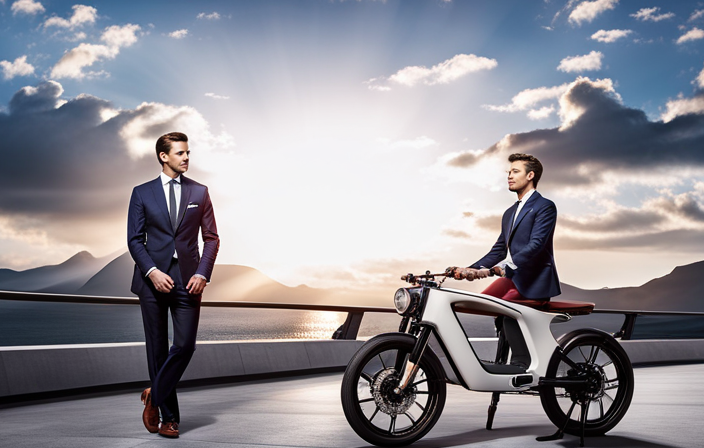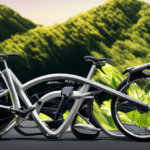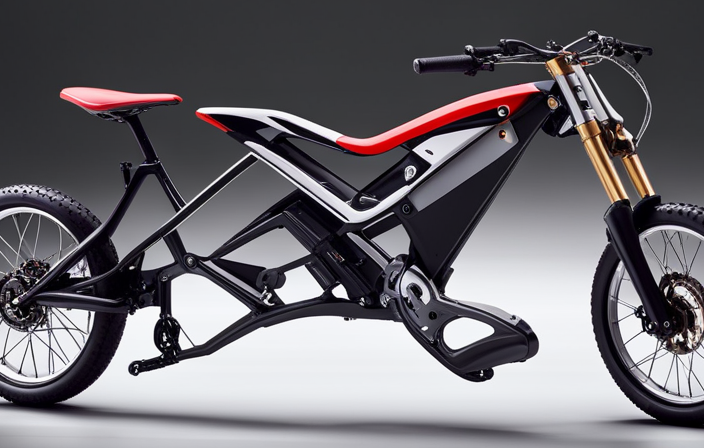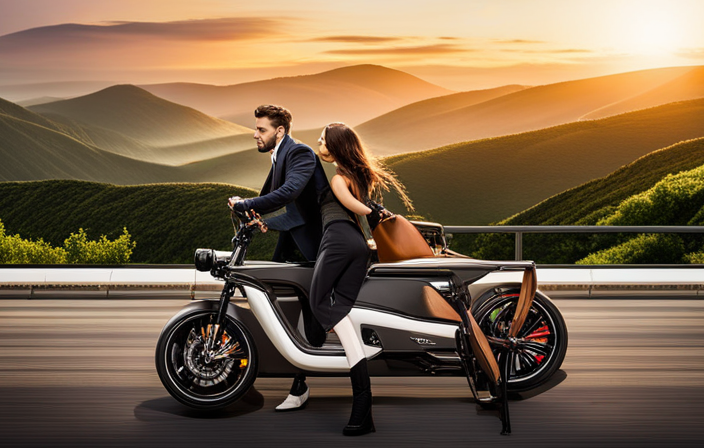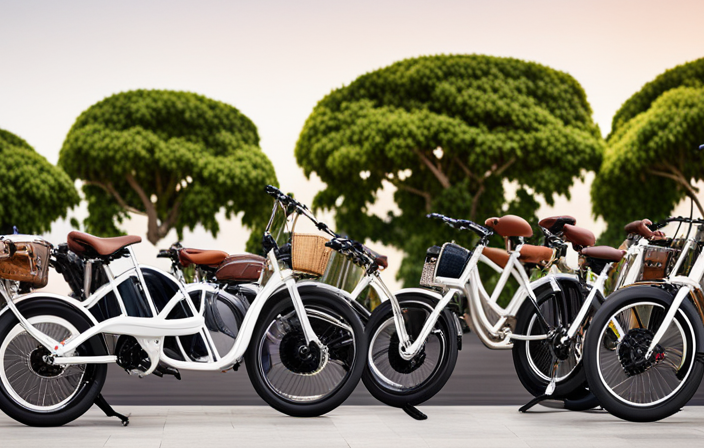Did you know that the average lifespan of an electric bike battery is around 3 to 5 years? That means at some point, you’ll need to replace it.
But how much will that cost you? In this article, I’ll break down the price range for replacement batteries, factors that affect the cost, and where to buy them.
Additionally, I’ll discuss the pros and cons of different battery types and provide maintenance tips to help you maximize the lifespan of your electric bike battery.
Let’s dive in!
Key Takeaways
- The average lifespan of an electric bike battery is 3 to 5 years, and it’s important to consider battery maintenance and factors that can affect its lifespan.
- The cost of a replacement battery for an electric bike depends on factors such as battery capacity, brand, voltage, amperage, and technology, and it’s important to consider these factors for cost estimation.
- Battery capacity plays a significant role in the performance and lifespan of an electric bike, and larger capacity batteries can offer cost-saving benefits.
- When choosing a replacement battery, it’s important to consider the brand, quality, and reliability of the battery, as well as balance cost and quality.
Types of Electric Bike Batteries
You’ll find that there are various types of electric bike batteries available. When it comes to battery lifespan, lithium-ion batteries tend to be the most durable and long-lasting option. They can typically last for around 500-1000 charge cycles before their capacity starts to degrade.
On the other hand, lead-acid batteries have a shorter lifespan of around 300-500 charge cycles.
In terms of charging methods, most electric bike batteries can be charged using a standard wall socket. However, some higher-end models may offer faster charging options, such as a specialized charger or a regenerative braking system that charges the battery while you ride.
These factors, along with others like battery capacity and weight, will ultimately affect the cost of a replacement battery for your electric bike.
Factors Affecting Battery Cost
When it comes to the cost of an electric bike battery replacement, there are several factors that can influence the price.
One of the key factors is the battery capacity and range, as higher capacity batteries tend to be more expensive.
Another factor is the brand and quality of the battery, with well-known and reputable brands typically commanding higher prices.
Additionally, the battery voltage and amperage, as well as the technology and features incorporated into the battery, can also affect its cost.
Battery Capacity and Range
The battery capacity and range of an electric bike can greatly impact its overall performance. A higher battery capacity means the bike can travel longer distances before needing a recharge. Additionally, a larger battery capacity often results in a longer battery lifespan, as the cells are not being fully discharged with each use. This can save money in the long run, as replacement batteries are a significant expense. Charging time is another important factor to consider. A larger battery capacity may require a longer time to fully charge, so it’s crucial to plan charging times accordingly. To give you a better idea of how battery capacity and range can vary, here’s a table showcasing examples of electric bike batteries and their corresponding capacities and ranges:
| Battery Capacity (Wh) | Range (miles) |
|---|---|
| 300 | 20 |
| 500 | 35 |
| 700 | 50 |
| 1000 | 70 |
Considering battery brand and quality is another crucial step in determining the cost of a replacement battery for an electric bike.
Battery Brand and Quality
A crucial factor in determining the cost of a replacement battery for an e-bike is the brand and quality of the battery. Different brands offer batteries with varying levels of performance and lifespan. Higher quality batteries often come with a longer lifespan and better overall performance, which can significantly affect the price.
It’s important to consider these factors when choosing a replacement battery, as a cheaper option may not last as long or provide the same level of performance as a higher quality battery. When comparing prices, it’s essential to take into account the brand reputation and customer reviews to ensure you’re getting a reliable product.
Moving on to the next section about battery voltage and amperage, it’s important to understand how these factors affect the overall performance of an e-bike.
Battery Voltage and Amperage
One important factor to consider is how battery voltage and amperage impact an e-bike’s performance. The voltage of the battery determines the power output, while the amperage determines the capacity or energy storage.
Higher voltage batteries provide more power, allowing for faster acceleration and better climbing abilities. On the other hand, higher amperage batteries have a larger capacity, offering a longer range per charge. It’s crucial to find the right balance between voltage and amperage to meet your specific needs.
Additionally, battery lifespan and charging also depend on these factors. Higher voltage and amperage batteries may have a shorter lifespan and require more frequent charging. This is an important consideration when choosing a replacement battery.
Moving forward, let’s dive into the exciting world of battery technology and features, exploring the advancements that have revolutionized e-bike performance.
Battery Technology and Features
Moving on from discussing battery voltage and amperage, let’s now delve into the fascinating world of battery technology and its various features. As an enthusiast of electric bikes, I find it essential to understand the intricacies of battery charging techniques and stay updated on future advancements in battery technology. Keeping up with these advancements ensures that I make the most out of my electric bike’s battery life and performance.
It’s truly remarkable to witness how battery technology has evolved over time, offering improved energy density, longer lifespan, and faster charging capabilities. To bring this into perspective, here are three remarkable advancements in battery technology that continue to revolutionize the electric bike industry:
-
Lithium-ion batteries: These lightweight and high-capacity batteries have become the gold standard for electric bikes due to their excellent energy storage capabilities.
-
Smart charging systems: These advanced systems optimize the battery’s charging process, ensuring efficient energy transfer and extending battery life.
-
Solid-state batteries: The future holds great promise with these innovative batteries that offer even higher energy density and faster charging speeds.
Now, let’s explore the average price range for replacement batteries.
Average Price Range for Replacement Batteries
The average price range for replacement batteries for electric bikes is usually around $500 to $800. When considering the cost of a new battery, it is important to also think about the battery lifespan and the factors that can affect it.
The lifespan of an electric bike battery typically ranges from 2 to 5 years, depending on usage and maintenance. Factors such as temperature, charging habits, and the quality of the battery can all impact its overall life. It is essential to properly care for and maintain your battery to maximize its lifespan.
Now that we understand the average price range and the factors affecting battery life, let’s explore where to buy replacement batteries for electric bikes.
Where to Buy Replacement Batteries
You can find replacement batteries for your e-bike at various online retailers and specialty stores. Here are some options for where to find affordable replacement batteries:
-
Online retailers: Websites like Amazon, eBay, and Alibaba offer a wide range of replacement batteries for electric bikes. These online platforms often have competitive prices and customer reviews to help you make an informed decision.
-
Specialty stores: Local bike shops and stores that specialize in electric bikes may carry replacement batteries. These stores have knowledgeable staff who can provide guidance on choosing the right battery for your e-bike.
-
Manufacturer websites: Check the website of the electric bike manufacturer. They often have an online store where you can purchase genuine replacement batteries.
The best time to buy replacement batteries is during sales events or promotional periods when you can find discounted prices.
Now, let’s move on to considerations when choosing a replacement battery.
Considerations When Choosing a Replacement Battery
When selecting a new battery, it’s important to consider factors like voltage, capacity, and compatibility with your e-bike model. Battery compatibility is crucial because not all batteries are designed to work with every electric bike. You need to ensure that the replacement battery you choose is specifically made for your bike’s make and model.
Additionally, it’s essential to estimate the battery lifespan before making a purchase. This can be tricky since it depends on various factors such as usage, terrain, and battery maintenance. However, you can typically find estimates provided by the manufacturer or online reviews from other e-bike users. Understanding the estimated lifespan of a replacement battery will help you make an informed decision.
With this knowledge, you can proceed to the subsequent section about tips for extending battery lifespan without compromising performance or longevity.
Tips for Extending Battery Lifespan
One way to prolong the lifespan of your e-bike’s battery is by properly maintaining it. Here are some battery maintenance tips to help you extend its lifespan:
- Charge your battery regularly, even if you don’t use your e-bike often.
- Avoid letting your battery fully discharge, as this can shorten its lifespan.
- Store your battery in a cool and dry place, away from extreme temperatures.
- Clean the battery terminals regularly to prevent corrosion.
- Avoid exposing your battery to water or other liquids.
By following these battery maintenance tips, you can ensure that your e-bike’s battery lasts longer and performs at its best.
Now, let’s move on to the next section about DIY battery replacement vs. professional installation.
DIY Battery Replacement vs. Professional Installation
If you’re considering replacing your e-bike’s battery, you may be wondering whether to tackle the task yourself or seek professional assistance.
DIY battery replacement offers several benefits. Firstly, it allows you to save money on labor costs, as professional installation can be quite expensive. Additionally, doing it yourself gives you a better understanding of your bike’s electrical system and helps you become more self-reliant in maintaining your e-bike.
However, professional installation has its advantages too. Experts have the necessary knowledge and experience to ensure a proper and efficient battery replacement. They can also diagnose any other issues your bike may have and address them simultaneously.
As we transition into the subsequent section about battery recycling and disposal, it’s important to consider the environmental impact of your old battery and how to dispose of it responsibly.
Battery Recycling and Disposal
Properly disposing of your old e-bike battery is essential for minimizing environmental impact. When it comes to battery recycling and disposal, there are several options available. Many manufacturers and retailers have implemented battery recycling programs, allowing customers to return their old batteries for proper disposal. These programs ensure that batteries are recycled in an environmentally responsible manner, reducing the amount of waste that ends up in landfills. Additionally, some local recycling centers accept e-bike batteries for recycling. It is important to check with your local recycling facility to determine if they accept e-bike batteries and what their specific requirements are. By recycling your old e-bike battery, you are not only preventing harmful chemicals from leaching into the environment, but you are also contributing to the conservation of valuable resources. Transitioning into the subsequent section about ‘additional costs to consider’, it is important to be aware of the potential expenses associated with battery replacement.
Additional Costs to Consider
When considering the total cost of ownership, it’s important to factor in potential additional expenses. Here are some additional costs to consider when purchasing a replacement battery for an electric bike:
-
Battery Warranty: Check if the replacement battery comes with a warranty. This will give you peace of mind knowing that you are protected in case of any defects or malfunctions.
-
Battery Charging Time: Different replacement batteries may have varying charging times. It’s worth considering the charging time of the battery to ensure that it aligns with your needs and lifestyle.
-
Battery Accessories: Some replacement batteries may require additional accessories such as a charger or cables. These accessories may not be included in the initial purchase and can add to the overall cost.
Considering these factors will help you make an informed decision when purchasing a replacement battery for your electric bike.
Now, let’s delve into user reviews and recommendations to further guide you in choosing the right battery.
User Reviews and Recommendations
Take a look at what other users have to say about their experiences and recommendations for choosing the right battery for your e-bike. User satisfaction plays a crucial role in determining the quality of a replacement battery.
Many users emphasize the importance of battery performance, stating that a reliable and long-lasting battery is essential for a great riding experience. Users have reported increased range and improved power delivery with certain battery models, leading to higher overall satisfaction.
Some users have also provided recommendations for specific brands and models that they have had positive experiences with. These insights from fellow users can be invaluable in making an informed decision when purchasing a replacement battery for your e-bike.
Moving forward, let’s delve into some case studies to get a better understanding of battery replacement costs.
Case Studies: Examples of Battery Replacement Costs
After reading user reviews and recommendations, it’s clear that finding the right replacement battery for an electric bike can be a challenge. However, it’s important to consider all options before making a decision.
In this section, I will provide you with real-life case studies that highlight different battery replacement costs and alternatives. By exploring these examples, you can gain insights into cost-saving strategies and make an informed choice.
Markdown bullet point list:
- Explore refurbished batteries: These batteries can be a more affordable option and still provide reliable performance.
- Consider aftermarket batteries: These batteries are often cheaper than original manufacturer replacements and can be a viable alternative.
- Look into DIY battery repair kits: These kits can help you replace individual battery cells, saving you money compared to buying a whole new battery.
Now, let’s delve into the pros and cons of different battery types to give you a comprehensive understanding of your options.
Pros and Cons of Different Battery Types
One important consideration is the pros and cons of various types of batteries. When it comes to electric bike batteries, there are three main types: Lithium-ion, Nickel-metal hydride (NiMH), and Lead-acid. Each type has its own advantages and disadvantages.
To help you understand the differences, here is a table summarizing the pros and cons of each battery type:
| Battery Type | Pros | Cons |
|---|---|---|
| Lithium-ion | Longer battery life, lightweight, faster charging | Higher cost, environmental impact |
| NiMH | Lower cost, less environmental impact | Shorter battery life, heavier weight |
| Lead-acid | Lowest cost, widely available | Shortest battery life, heaviest weight, environmental impact |
When choosing a replacement battery for your electric bike, you should consider factors such as battery longevity and environmental impact. It’s important to find a balance between cost, performance, and sustainability. In the next section, we will discuss common battery issues and troubleshooting techniques, ensuring you get the most out of your electric bike.
Common Battery Issues and Troubleshooting
A common issue with batteries is their susceptibility to environmental factors, such as extreme temperatures and moisture. These factors can significantly affect the performance and lifespan of the battery.
Here are some common battery issues and troubleshooting techniques to consider:
-
Insufficient charging techniques: Improper charging methods, such as overcharging or undercharging, can lead to reduced battery capacity and performance. It’s important to follow the manufacturer’s recommended charging guidelines.
-
Signs of a failing battery: Frequent power loss, reduced range, and difficulty in holding a charge are some indications of a failing battery. These signs shouldn’t be ignored and may require professional assistance.
-
Extreme temperatures: Both high and low temperatures can negatively impact the battery’s performance. It’s essential to avoid exposing the battery to extreme temperatures to maintain its longevity.
-
Moisture damage: Moisture can corrode the battery terminals and damage the internal components. It’s crucial to keep the battery dry and protected.
By understanding these common battery issues and troubleshooting techniques, you can ensure better battery maintenance and care, ultimately prolonging the lifespan of your electric bike battery.
Battery Maintenance and Care Tips
To ensure optimal performance and longevity, it’s important to regularly maintain and care for your e-bike’s battery. Proper battery maintenance can help prevent common issues and extend the lifespan of your battery. One key aspect of maintenance is understanding battery charging techniques. It’s essential to follow the manufacturer’s guidelines for charging your battery, such as using the recommended charger and avoiding overcharging. Additionally, troubleshooting battery issues promptly is crucial. If you notice any abnormalities like reduced range or sudden power loss, it’s important to investigate and address the issue as soon as possible. Regularly inspecting the battery for any signs of damage or wear and keeping it clean can also contribute to its longevity. By following these battery maintenance and care tips, you can optimize the performance of your e-bike’s battery and minimize the need for a replacement. In the next section, we will discuss budgeting for a replacement battery.
Conclusion: Budgeting for a Replacement Battery
In conclusion, it’s important to consider budgeting for a new battery when planning for the future maintenance of your e-bike. Here are some factors to consider when budgeting for a replacement battery:
-
Battery Type: The cost of a replacement battery can vary depending on the type of battery your e-bike uses. Lithium-ion batteries tend to be more expensive but offer longer lifespan and better performance compared to lead-acid batteries.
-
Brand and Quality: Higher-end brands often come with a higher price tag, but they also offer better quality and reliability. It’s worth investing in a reputable brand to ensure a longer-lasting battery.
-
Capacity and Range: The capacity of the battery affects its price. If you need a battery with a larger capacity and longer range, be prepared to pay more.
-
Warranty: Consider the warranty period offered by the manufacturer. A longer warranty can provide peace of mind and potentially save you money on replacement costs.
By considering these factors, you can plan your budget effectively and ensure you have funds set aside for a replacement battery when the time comes.
Frequently Asked Questions
Can I use any type of battery as a replacement for my electric bike?
No, not all batteries are compatible with electric bikes. It is important to choose a battery that is compatible with your specific bike model to ensure optimal performance. Batteries should be compared based on their performance and compatibility.
How long does a replacement battery typically last?
A replacement battery typically lasts for around 2-3 years, but its lifespan can be extended with proper care and maintenance. To dispose of an old electric bike battery, it’s important to follow the proper recycling procedures to minimize environmental impact.
Are there any warranties or guarantees offered for replacement batteries?
Yes, there are warranties and guarantees offered for replacement batteries. These warranties typically cover defects in materials and workmanship and can vary in length. The cost of a replacement battery depends on the brand and capacity.
Can I upgrade to a higher capacity battery when replacing my electric bike’s battery?
When upgrading your electric bike’s battery, you can increase its capacity, enhancing your riding experience. This allows for longer trips and improved performance, making it a worthwhile investment.
Are there any potential safety hazards associated with replacing an electric bike battery?
When replacing an electric bike battery, it is important to be aware of potential safety hazards. Take precautions by following manufacturer guidelines, ensuring proper wiring connections, and avoiding exposure to water or extreme temperatures.
Conclusion
So, after delving into the world of electric bike batteries, I must say, it’s been quite a ride!
We’ve explored the various types of batteries, discussed the factors that affect their cost, and even pondered over where to find replacement batteries.
But fear not, my fellow riders, for in our quest for knowledge, we have also discovered the pros and cons of different battery types, learned how to troubleshoot common issues, and gained valuable maintenance tips.
Now, armed with this newfound wisdom, we can confidently budget for a replacement battery and keep our electric bikes rolling smoothly for miles to come.
Happy riding!
